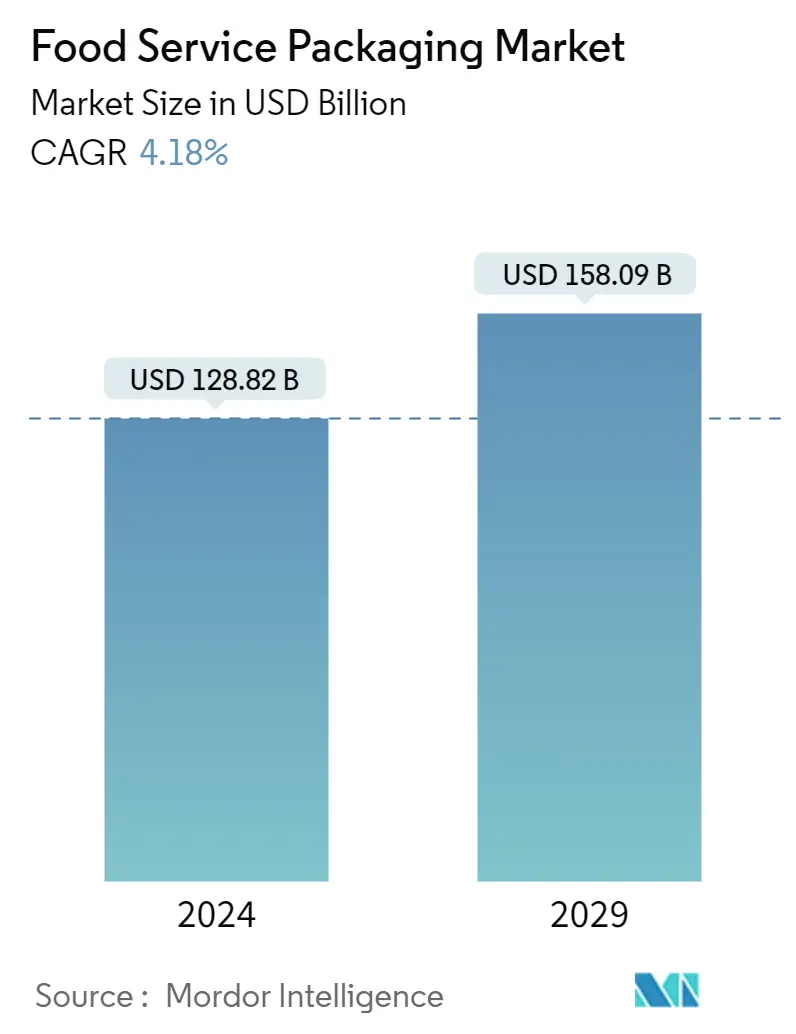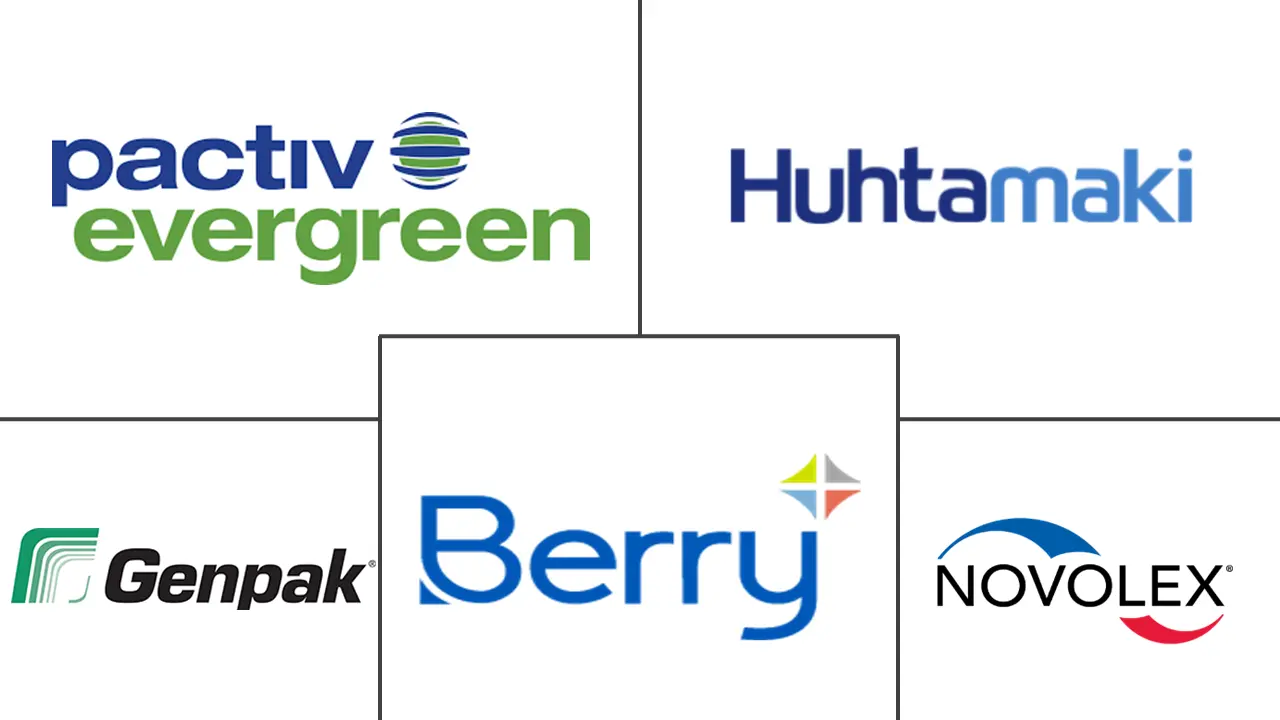Market Size of Food Service Packaging Industry

| Study Period | 2019 - 2029 |
| Market Size (2024) | USD 128.82 Billion |
| Market Size (2029) | USD 158.09 Billion |
| CAGR (2024 - 2029) | 4.18 % |
| Fastest Growing Market | Asia Pacific |
| Largest Market | Asia Pacific |
Major Players
*Disclaimer: Major Players sorted in no particular order |
Food Service Packaging Market Analysis
The Food Service Packaging Market size is estimated at USD 128.82 billion in 2024, and is expected to reach USD 158.09 billion by 2029, growing at a CAGR of 4.18% during the forecast period (2024-2029).
- Online delivery platforms and mobile apps fuel the growth of foodservice packaging products. This surge is poised to intensify as technology reshapes the food landscape, drawing in more investments. Third-party online food ordering services are expected to surge, empowering numerous small, independent eateries to tap into a wider customer base. Additionally, the growth of quick service restaurants (QSRs), including online delivery food trucks, bolsters the demand for foodservice packaging, especially disposables.
- Over the last few years, online food ordering and restaurant delivery have grown more than 20%. With the increasing adoption of the online food delivery system, the demand and use of sustainable packaging are rising, causing manufacturers to opt for sustainable packaging solutions.
- Cafés and restaurants worldwide are on the rise, propelling the foodservice packaging market. In China alone, the café count surged from 115.82 thousand in 2022 to 132.83 thousand in 2023, as reported by CBN-Data. This uptick in café numbers directly fuels the demand for foodservice packaging. Given that many cafes prioritize takeout options, the need for packaging, such as paper bags and plastic containers, becomes paramount. Consequently, with the expanding café and restaurant landscape, the demand for retail bags is poised to climb.
- Several packaging companies, such as Hinojosa, assist firms in promoting more environmentally friendly consumption habits in the food and beverage industry, strategically making it easier to include sustainability as a competitive advantage. Foodservice was one of the industries with the most significant demand for plastic packaging, which witnessed plastic usage climb by more than 33% in 2021.
- In March 2023, Hinojosa Packaging Group launched a new line of foodservice packaging products that offers a range of solutions using printing methods safe for contact with food. This container is constructed entirely of recyclable paper and is biodegradable, which makes it stand out from other packaging.
- However, sustainable packaging can be expensive and challenging to develop. Many businesses need more resources, and investing in R&D would be required for better packaging. The potential cost savings from streamlined packaging must be considered. The cost of using sustainable packaging is higher than conventional packaging. This is due to the materials involved and their sourcing (both virgin and used), the less-established supply chains, manufacturing processes, and lower economies of scale.
- Enhanced packaging materials and customization are pivotal drivers of growth in the foodservice packaging market. They not only meet evolving consumer preferences but also bolster brand identity and tackle sustainability concerns. In April 2024, Sabert Corporation, a leading innovator in food packaging, unveiled its latest range: Pulp Protein and Produce Trays. These Trays, certified as commercially compostable, offer foodservice operators a sustainable choice over conventional foam trays, all while maintaining top-tier quality and performance.
Food Service Packaging Industry Segmentation
Foodservice packaging includes single-use and recyclable containers and products used for serving or packaging prepared foods and drinks in eat-in or takeaway food service establishments and increasingly for home delivery. The report offers an up-to-date analysis of the current market scenario, the latest trends and drivers, and the overall market environment. The report also identifies the continuous development of new products as one of the prime market growth drivers over the next few years.
The foodservice packaging market is segmented by product type (corrugated boxes and cartons, plastic bottles, trays, plates, food containers, bowls, cups, and lids, clamshells, and other product types), end user (quick service restaurants (QSR), full service restaurants (FSR), institutional, hospitality, and other end users), and geography (North America [the United States and Canada], Europe [the United Kingdom, Germany, France, Italy, Spain and Rest of Europe], Asia-Pacific [China, India, Japan, Australia and New Zealand, and Rest of Asia-Pacific], Latin America [Brazil, Argentina, Mexico, and Rest of Latin America], and Middle East and Africa [Saudi Arabia, the United Arab Emirates, South Africa, and Rest of Middle East and Africa]). The market sizes and forecasts are provided in terms of value (USD) for all the above segments.
| By Product Type | |
| Corrugated Boxes And Cartons | |
| Plastic Bottles | |
| Trays, Plates, Food Containers, And Bowls | |
| Cups And Lids | |
| Clamshells | |
| Other Product Types |
| By End-user Industries | |
| Quick Service Restaurants (QSR) | |
| Full-service Restaurants (FSR) | |
| Institutional | |
| Hospitality (Dine-ins, Coffee & Snack, Etc.) | |
| Other End-user Industries |
| By Geography | |||||||
| |||||||
| |||||||
| |||||||
| |||||||
|
Food Service Packaging Market Size Summary
The food service packaging market is experiencing significant growth, driven by the increasing popularity of online food ordering and restaurant delivery services. This trend has led to a rising demand for sustainable packaging solutions, as manufacturers seek to align with consumer preferences for environmentally friendly options. The expansion of cafés and restaurants, particularly in regions like Australia, further fuels this demand, as these establishments require packaging for take-away food and drinks. Companies like Hinojosa are at the forefront of this shift, introducing innovative packaging solutions that emphasize sustainability. However, the transition to sustainable packaging presents challenges, including higher costs and the need for investment in research and development to improve packaging technologies.
The market is also influenced by the evolving consumer preferences and regulatory pressures, particularly in the quick-service restaurant (QSR) sector, where there is a push towards reducing the environmental impact of packaging materials. Initiatives by major brands, such as KFC and Burger King, to adopt reusable and biodegradable packaging solutions highlight the industry's commitment to sustainability. The Asia-Pacific region, with its rapidly growing demand for food services, is expected to lead the adoption of sustainable packaging. Despite the challenges, the market remains fragmented and attractive for new entrants, with ongoing innovations and partnerships aimed at enhancing the sustainability and efficiency of food service packaging solutions.
Food Service Packaging Market Size - Table of Contents
-
1. MARKET DYNAMICS
-
1.1 Market Overview
-
1.2 Industry Attractiveness - Porter's Five Forces Analysis
-
1.2.1 Bargaining Power of Suppliers
-
1.2.2 Bargaining Power of Buyers
-
1.2.3 Threat of New Entrants
-
1.2.4 Threat of Substitute Products
-
1.2.5 Intensity of Competitive Rivalry
-
-
1.3 Industry Ecosystem Analysis
-
-
2. MARKET SEGMENTATION
-
2.1 By Product Type
-
2.1.1 Corrugated Boxes And Cartons
-
2.1.2 Plastic Bottles
-
2.1.3 Trays, Plates, Food Containers, And Bowls
-
2.1.4 Cups And Lids
-
2.1.5 Clamshells
-
2.1.6 Other Product Types
-
-
2.2 By End-user Industries
-
2.2.1 Quick Service Restaurants (QSR)
-
2.2.2 Full-service Restaurants (FSR)
-
2.2.3 Institutional
-
2.2.4 Hospitality (Dine-ins, Coffee & Snack, Etc.)
-
2.2.5 Other End-user Industries
-
-
2.3 By Geography
-
2.3.1 North America
-
2.3.1.1 United States
-
2.3.1.2 Canada
-
-
2.3.2 Europe
-
2.3.2.1 United Kingdom
-
2.3.2.2 Germany
-
2.3.2.3 France
-
2.3.2.4 Italy
-
2.3.2.5 Spain
-
-
2.3.3 Asia
-
2.3.3.1 China
-
2.3.3.2 Japan
-
2.3.3.3 India
-
2.3.3.4 Australia and New Zealand
-
-
2.3.4 Latin America
-
2.3.4.1 Brazil
-
2.3.4.2 Argentina
-
2.3.4.3 Mexico
-
-
2.3.5 Middle East and Africa
-
2.3.5.1 Saudi Arabia
-
2.3.5.2 United Arab Emirates
-
2.3.5.3 South Africa
-
-
-
Food Service Packaging Market Size FAQs
How big is the Food Service Packaging Market?
The Food Service Packaging Market size is expected to reach USD 128.82 billion in 2024 and grow at a CAGR of 4.18% to reach USD 158.09 billion by 2029.
What is the current Food Service Packaging Market size?
In 2024, the Food Service Packaging Market size is expected to reach USD 128.82 billion.

